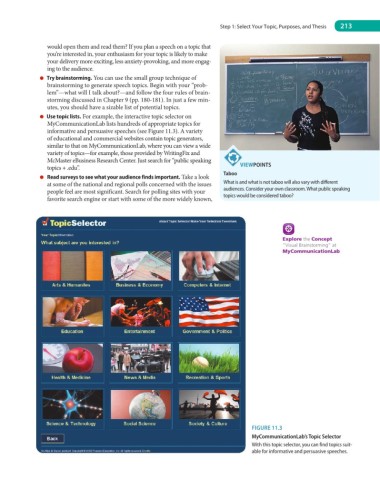Page 234 - Essentials of Human Communication
P. 234
Step 1: Select Your Topic, Purposes, and Thesis 213
would open them and read them? If you plan a speech on a topic that
you’re interested in, your enthusiasm for your topic is likely to make
your delivery more exciting, less anxiety-provoking, and more engag-
ing to the audience.
● Try brainstorming. You can use the small group technique of
brainstorming to generate speech topics. Begin with your “prob-
lem”—what will I talk about?—and follow the four rules of brain-
storming discussed in Chapter 9 (pp. 180-181). In just a few min-
utes, you should have a sizable list of potential topics.
● Use topic lists. For example, the interactive topic selector on
MyCommunicationLab lists hundreds of appropriate topics for
informative and persuasive speeches (see Figure 11.3). A variety
of educational and commercial websites contain topic generators,
similar to that on MyCommunicationLab, where you can view a wide
variety of topics—for example, those provided by WritingFix and
McMaster eBusiness Research Center. Just search for “public speaking
topics + .edu”. ViewpoinTS
● Read surveys to see what your audience finds important. Take a look Taboo
at some of the national and regional polls concerned with the issues What is and what is not taboo will also vary with different
people feel are most significant. Search for polling sites with your audiences. Consider your own classroom. What public speaking
favorite search engine or start with some of the more widely known, topics would be considered taboo?
Explore the Concept
“Visual Brainstorming” at
MyCommunicationLab
Figure 11.3
MyCommunicationLab’s Topic Selector
With this topic selector, you can find topics suit-
able for informative and persuasive speeches.

